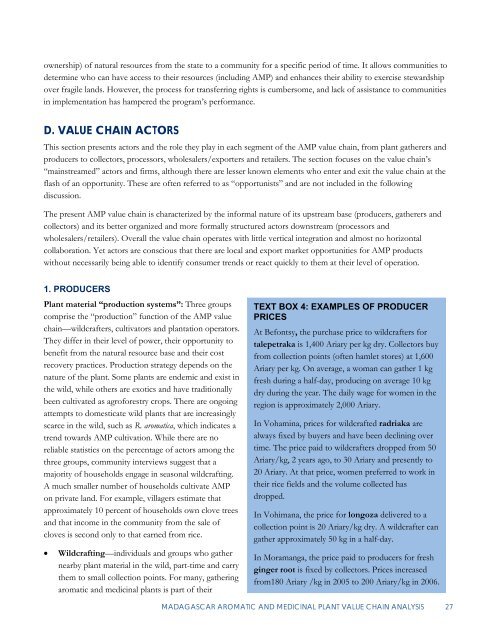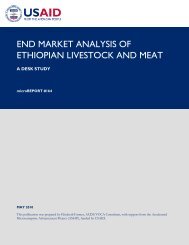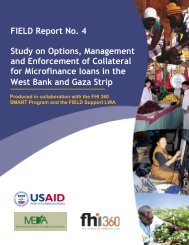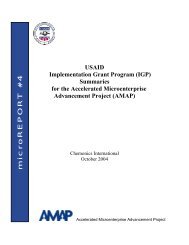Madagascar Aromatic and Medicinal Plants Value - Microlinks
Madagascar Aromatic and Medicinal Plants Value - Microlinks
Madagascar Aromatic and Medicinal Plants Value - Microlinks
Create successful ePaper yourself
Turn your PDF publications into a flip-book with our unique Google optimized e-Paper software.
ownership) of natural resources from the state to a community for a specific period of time. It allows communities to<br />
determine who can have access to their resources (including AMP) <strong>and</strong> enhances their ability to exercise stewardship<br />
over fragile l<strong>and</strong>s. However, the process for transferring rights is cumbersome, <strong>and</strong> lack of assistance to communities<br />
in implementation has hampered the program’s performance.<br />
D. VALUE CHAIN ACTORS<br />
This section presents actors <strong>and</strong> the role they play in each segment of the AMP value chain, from plant gatherers <strong>and</strong><br />
producers to collectors, processors, wholesalers/exporters <strong>and</strong> retailers. The section focuses on the value chain’s<br />
“mainstreamed” actors <strong>and</strong> firms, although there are lesser known elements who enter <strong>and</strong> exit the value chain at the<br />
flash of an opportunity. These are often referred to as “opportunists” <strong>and</strong> are not included in the following<br />
discussion.<br />
The present AMP value chain is characterized by the informal nature of its upstream base (producers, gatherers <strong>and</strong><br />
collectors) <strong>and</strong> its better organized <strong>and</strong> more formally structured actors downstream (processors <strong>and</strong><br />
wholesalers/retailers). Overall the value chain operates with little vertical integration <strong>and</strong> almost no horizontal<br />
collaboration. Yet actors are conscious that there are local <strong>and</strong> export market opportunities for AMP products<br />
without necessarily being able to identify consumer trends or react quickly to them at their level of operation.<br />
1. PRODUCERS<br />
Plant material “production systems”: Three groups<br />
comprise the “production” function of the AMP value<br />
chain—wildcrafters, cultivators <strong>and</strong> plantation operators.<br />
They differ in their level of power, their opportunity to<br />
benefit from the natural resource base <strong>and</strong> their cost<br />
recovery practices. Production strategy depends on the<br />
nature of the plant. Some plants are endemic <strong>and</strong> exist in<br />
the wild, while others are exotics <strong>and</strong> have traditionally<br />
been cultivated as agroforestry crops. There are ongoing<br />
attempts to domesticate wild plants that are increasingly<br />
scarce in the wild, such as R. aromatica, which indicates a<br />
trend towards AMP cultivation. While there are no<br />
reliable statistics on the percentage of actors among the<br />
three groups, community interviews suggest that a<br />
majority of households engage in seasonal wildcrafting.<br />
A much smaller number of households cultivate AMP<br />
on private l<strong>and</strong>. For example, villagers estimate that<br />
approximately 10 percent of households own clove trees<br />
<strong>and</strong> that income in the community from the sale of<br />
cloves is second only to that earned from rice.<br />
• Wildcrafting—individuals <strong>and</strong> groups who gather<br />
nearby plant material in the wild, part-time <strong>and</strong> carry<br />
them to small collection points. For many, gathering<br />
aromatic <strong>and</strong> medicinal plants is part of their<br />
TEXT BOX 4: EXAMPLES OF PRODUCER<br />
PRICES<br />
At Befontsy, the purchase price to wildcrafters for<br />
talepetraka is 1,400 Ariary per kg dry. Collectors buy<br />
from collection points (often hamlet stores) at 1,600<br />
Ariary per kg. On average, a woman can gather 1 kg<br />
fresh during a half-day, producing on average 10 kg<br />
dry during the year. The daily wage for women in the<br />
region is approximately 2,000 Ariary.<br />
In Vohamina, prices for wildcrafted radriaka are<br />
always fixed by buyers <strong>and</strong> have been declining over<br />
time. The price paid to wildcrafters dropped from 50<br />
Ariary/kg, 2 years ago, to 30 Ariary <strong>and</strong> presently to<br />
20 Ariary. At that price, women preferred to work in<br />
their rice fields <strong>and</strong> the volume collected has<br />
dropped.<br />
In Vohimana, the price for longoza delivered to a<br />
collection point is 20 Ariary/kg dry. A wildcrafter can<br />
gather approximately 50 kg in a half-day.<br />
In Moramanga, the price paid to producers for fresh<br />
ginger root is fixed by collectors. Prices increased<br />
from180 Ariary /kg in 2005 to 200 Ariary/kg in 2006.<br />
MADAGASCAR AROMATIC AND MEDICINAL PLANT VALUE CHAIN ANALYSIS 27





